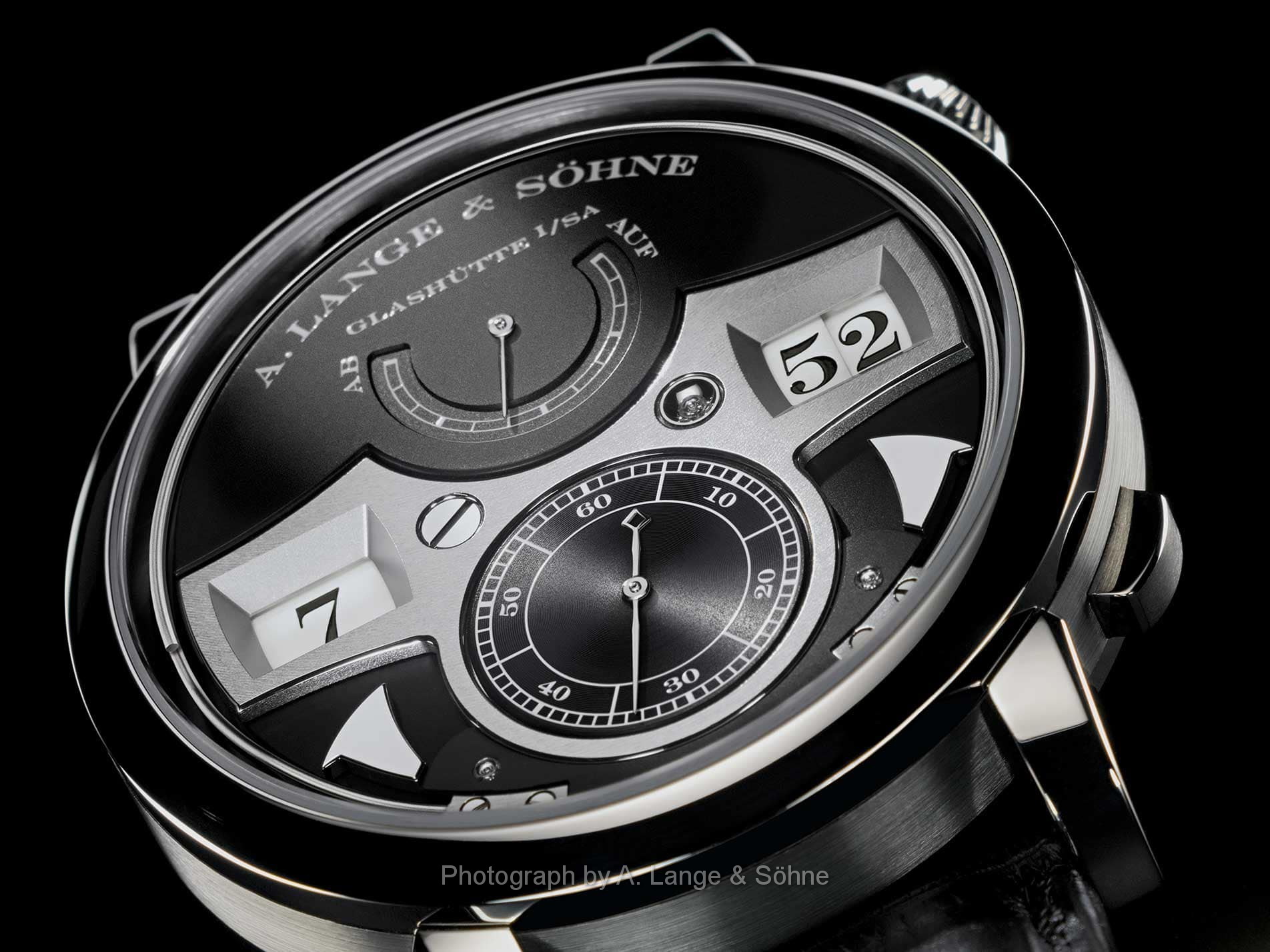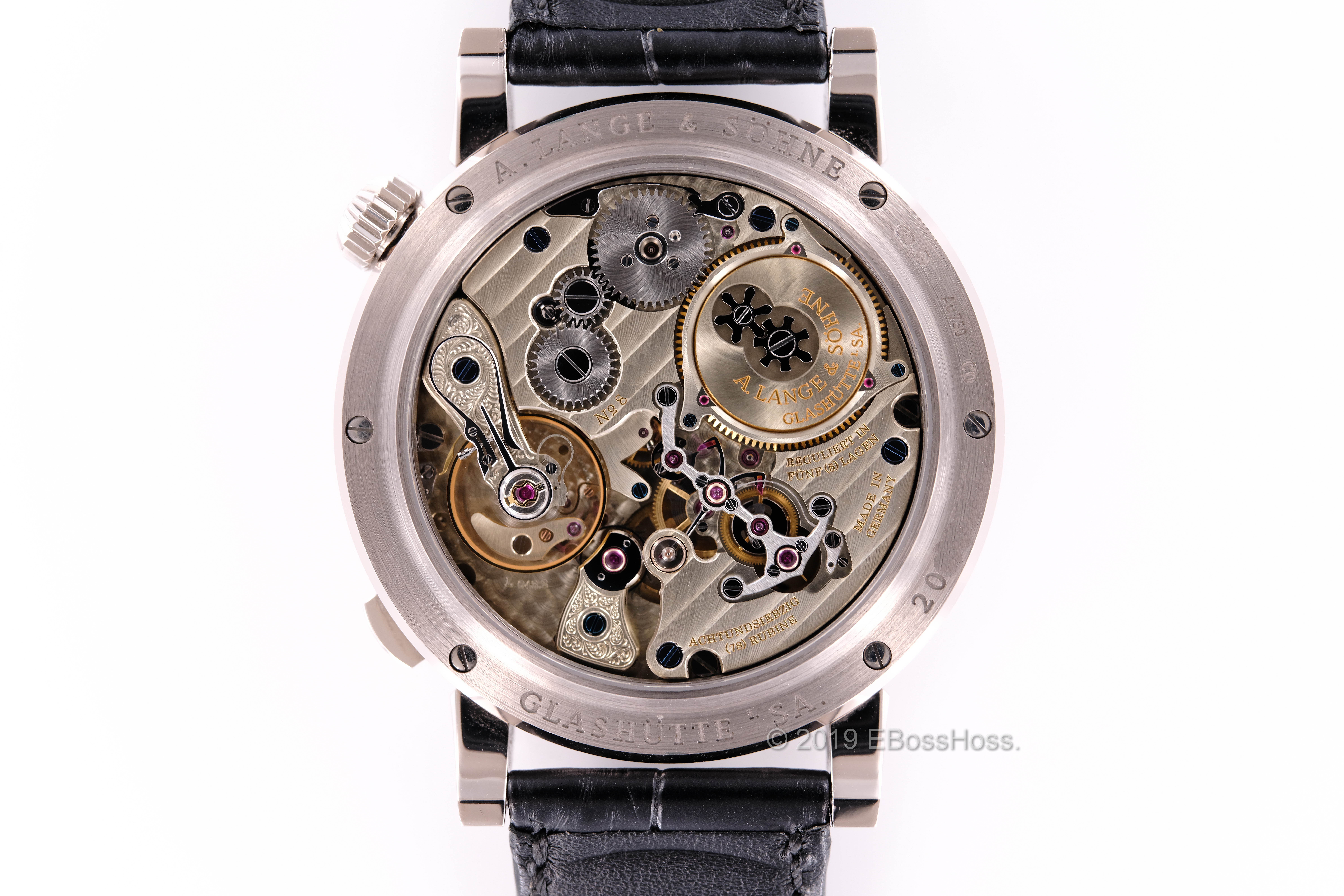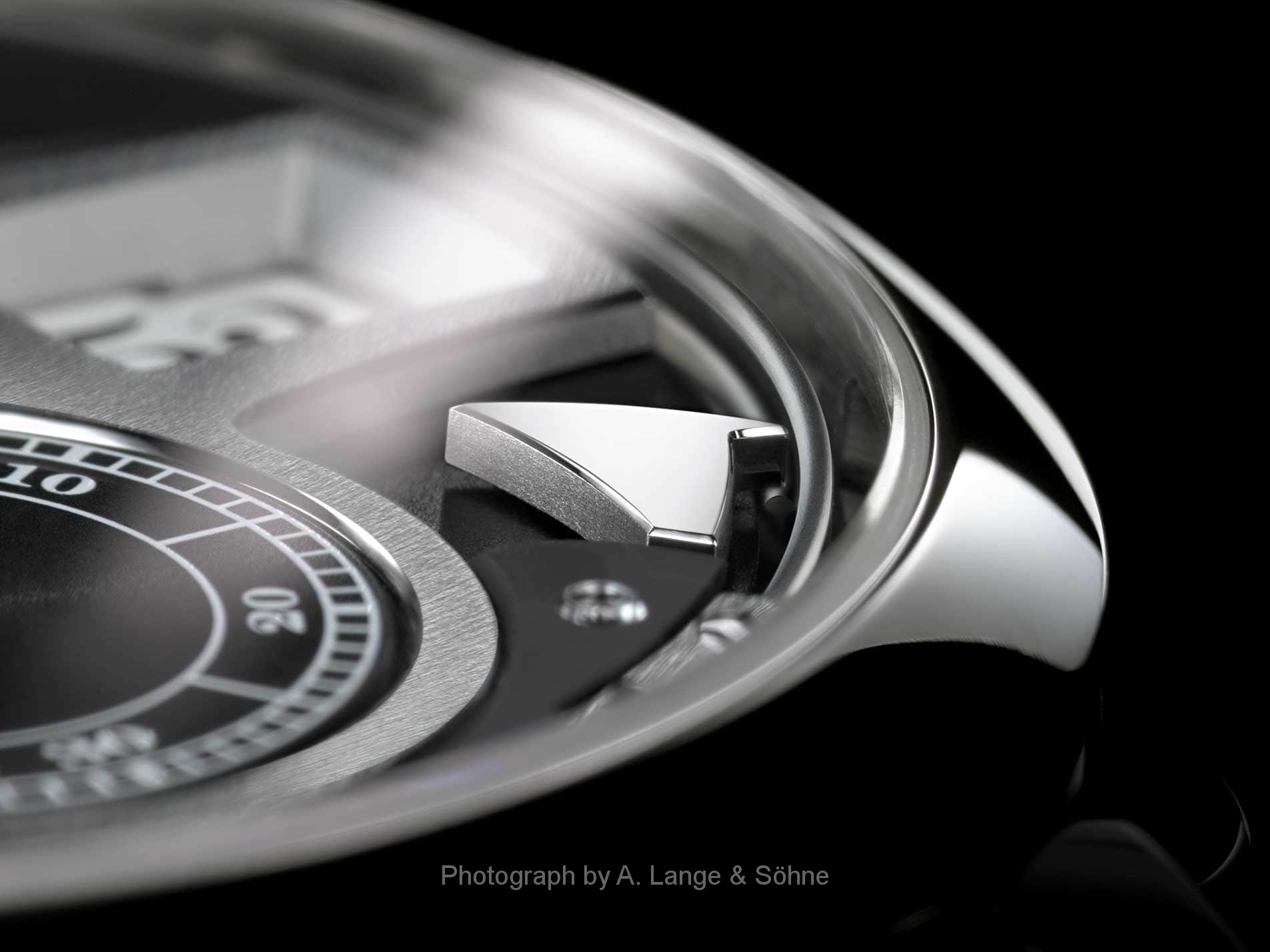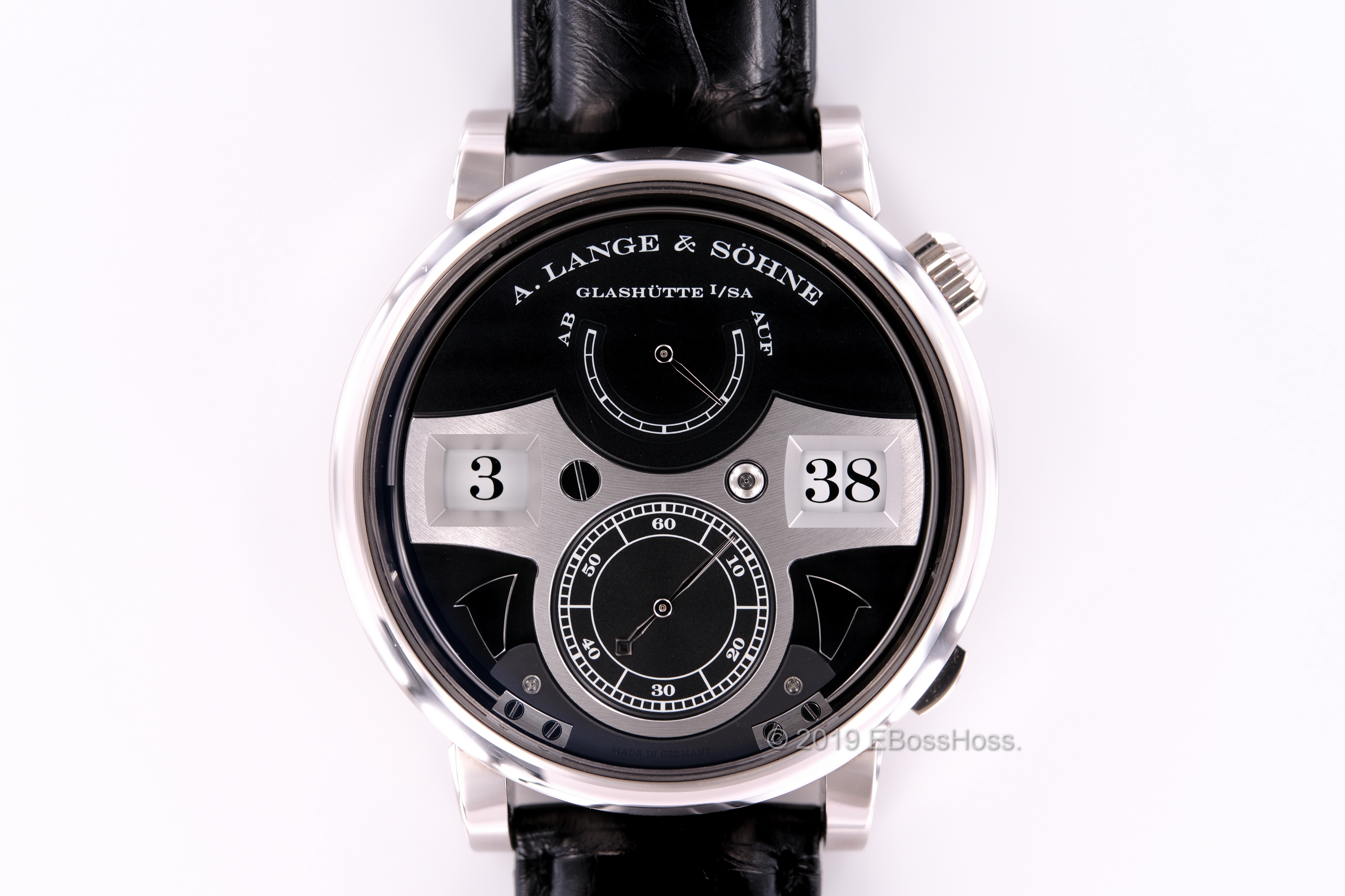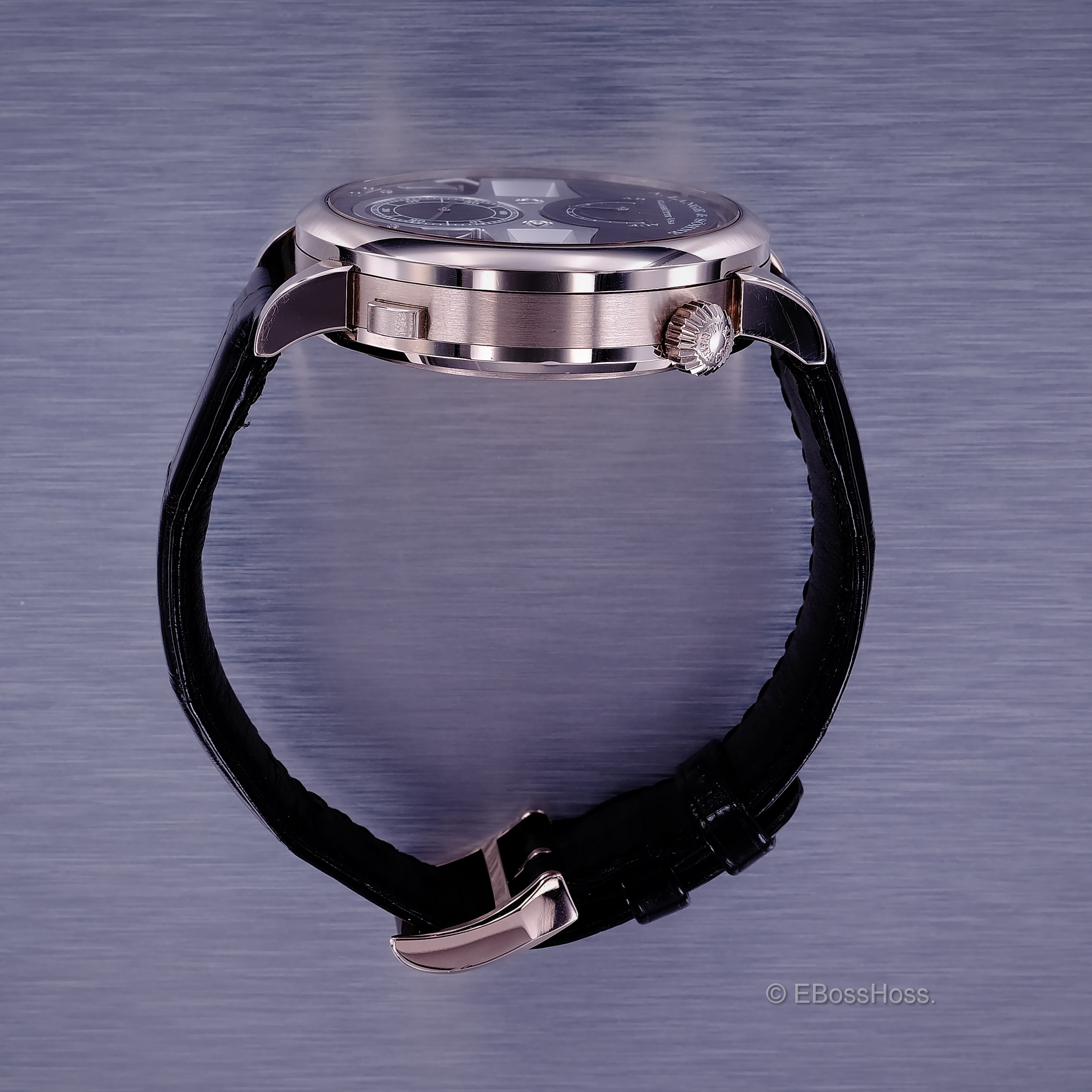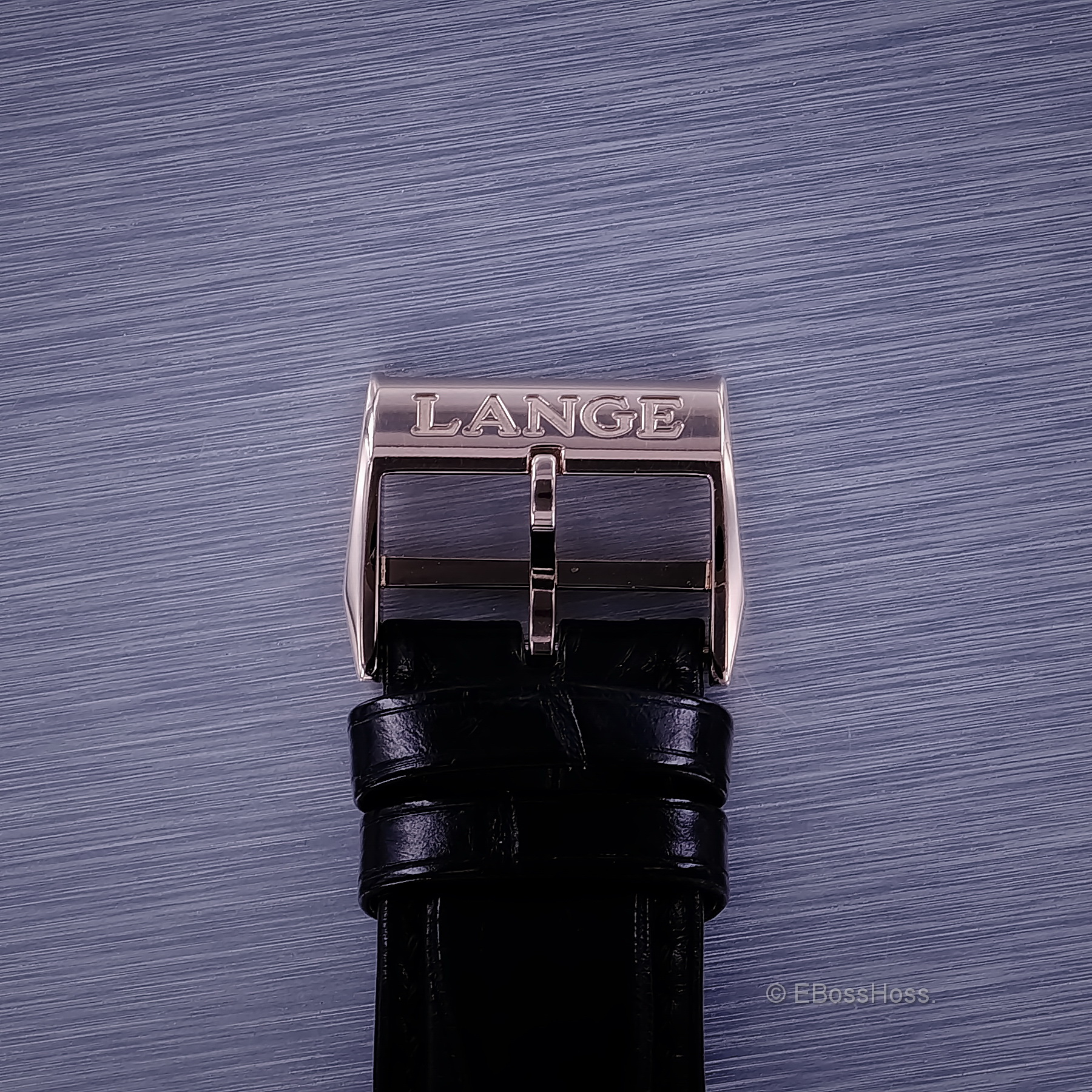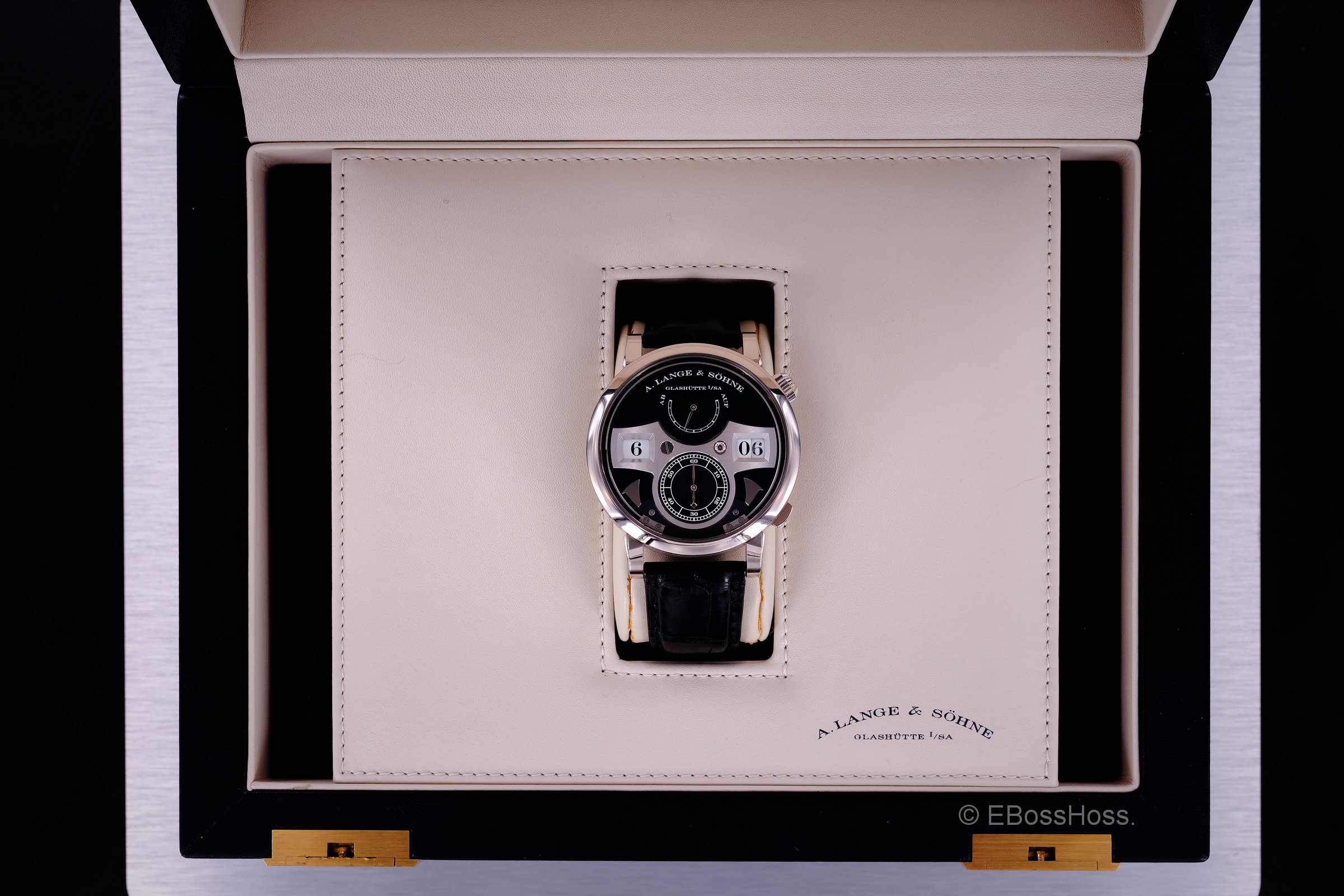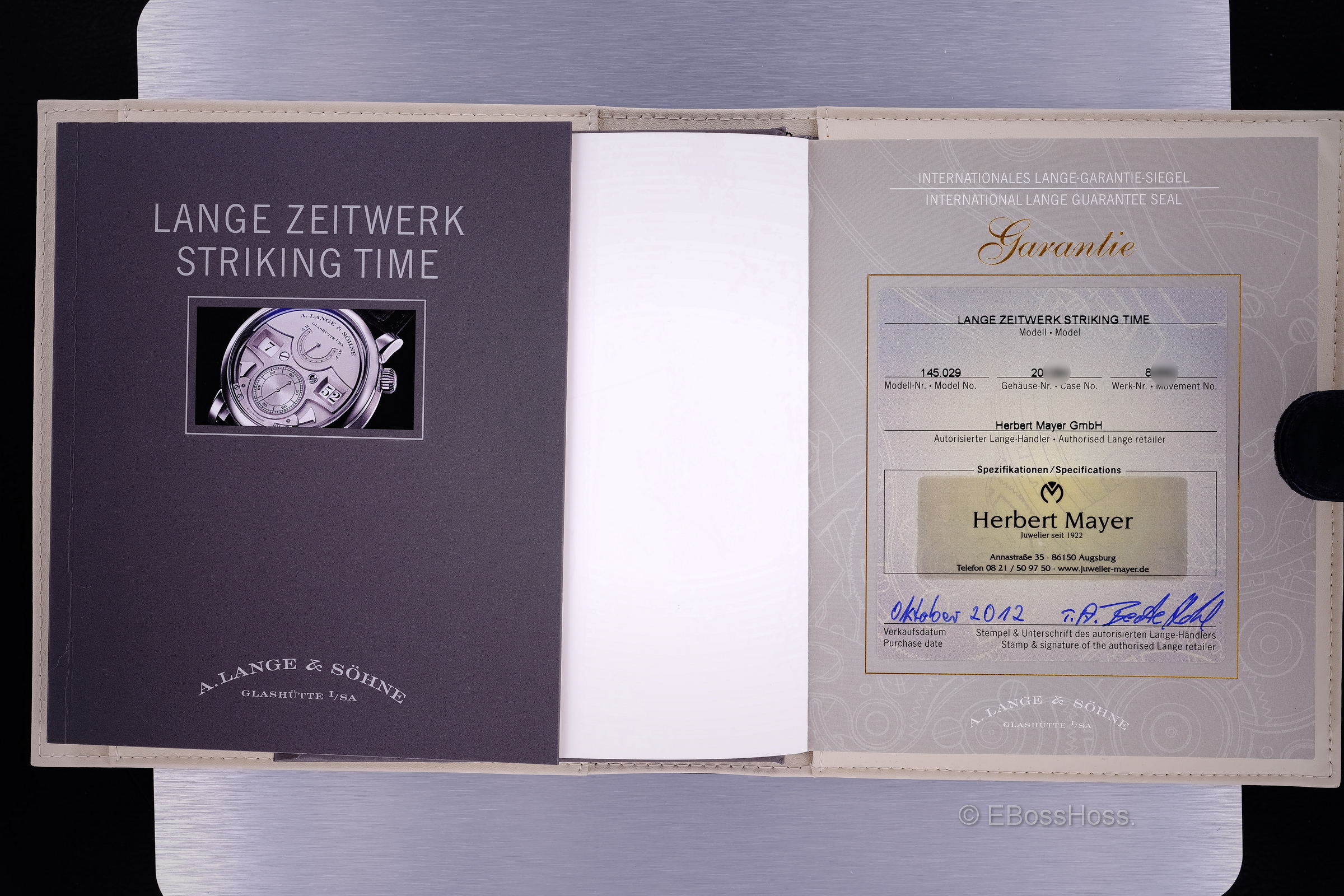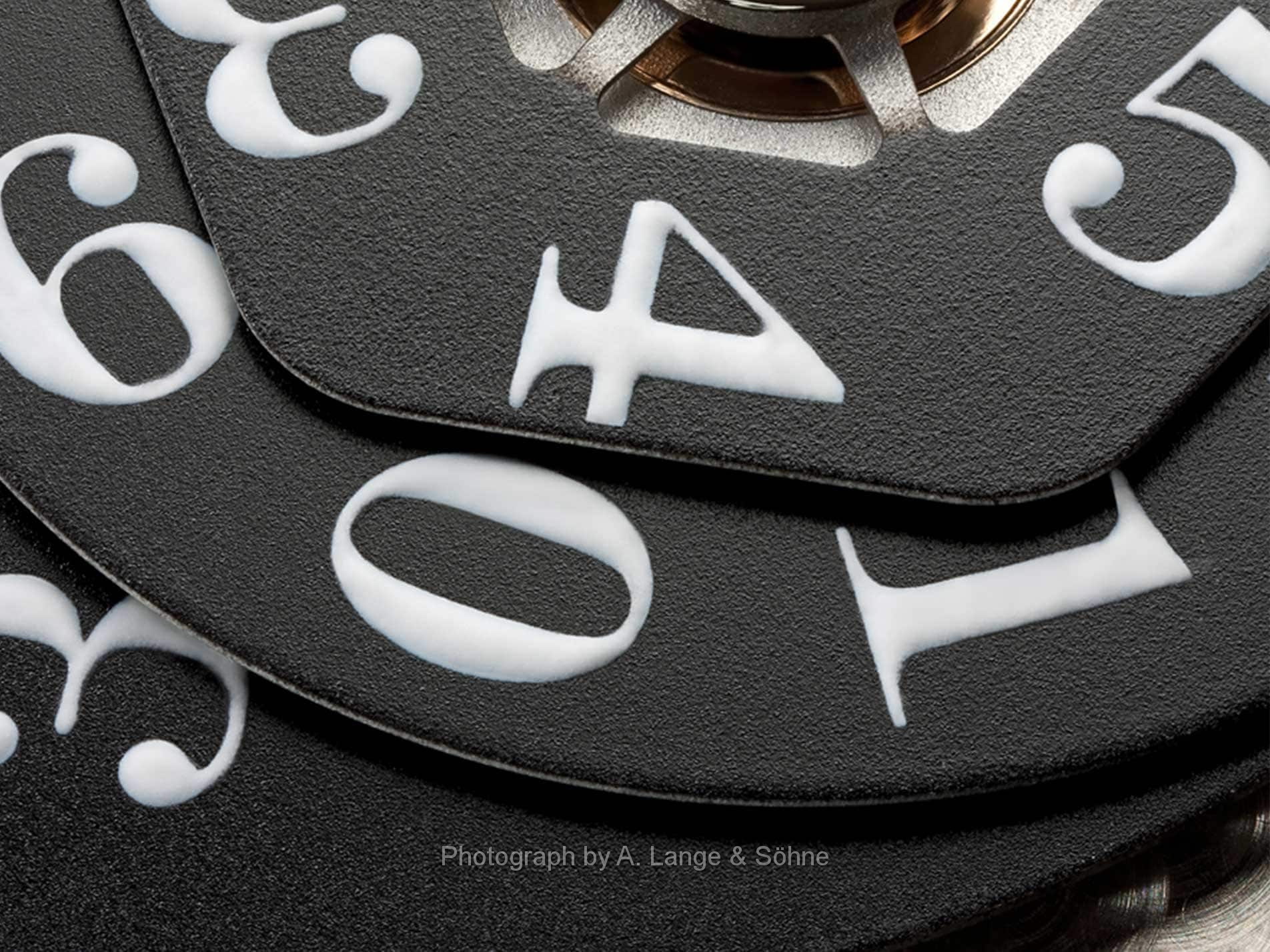Please INQUIRE for best CASH PRICE
Sold
44mm, White Gold, Croc, Original Box/Papers, Near Mint
The new era of the mechanical watch -- The ZEITWERK watch family
The ZEITWERK features a digital display and is one of the most advanced watches of the contemporary era. It is the first mechanical wristwatch with a jumping numerals mechanism consisting of three discs. This groundbreaking concept has received multiple
When they developed the ZEITWERK, Lange’s engineers questioned everything – except the mechanical paradigm. The result is a digital-display watch that no doubt ranks among the most progressive timepieces of our epoch. Its trailblazing concept with mechanically driven, precisely jumping numerals is unparalleled in watchmaking and appeals even to individuals who could not imagine that they would ever wear a digital timepiece.
A category of its own
The ZEITWERK is the first mechanical wristwatch that displays hours and minutes with jumping numerals. Its innovative concept comes to the fore with an inimitable design. The time bridge is one of the most prominent signature elements of its dial. It is part of the movement and constitutes the stage for all time indications.
The apertures for the hours and minutes are arranged from left to right; the numerals are large and crisply legible. With its iconic digital display concept, the ZEITWERK sets itself apart in the plethora of analog mechanical watches, establishing a category of its own.
Digital display – mechanical movement
In the past, the concept of the mechanical digital watch was implemented on several occasions but never in a really reliable manifestation. Lange’s masters solved the conceptual challenge with a jumping numerals mechanism that consists of three discs. The tremendous force needed to advance the discs is delivered by a patented mainspring barrel, and the precise timing is controlled by a patented constant-force escapement.
A prominent design feature of the ZEITWERK watch family: the time bridge.
The jumping numerals mechanism is based on three discs for the hours, the tens-minutes, and the units-minutes.
The energy needed to keep the watch running is supplied by a patented mainspring barrel, while the patented design of the constant-force escapement controls the exact ticking interval. This innovative concept has been realized with an inimitable design. One of the most striking design elements on the dial is the time bridge. It forms part of the movement and is simultaneously the frame for all time indications.
A resonant masterpiece
The steel of which the gongs are made is hardened in an elaborate process. To optimize the acoustics of the gongs, the weight of the gong hammers, their impact angle and their impact speed must be accurately matched to the gongs. The striking mechanism can be deactivated by actuating the button in the lower right-hand case flank. This causes the gong hammers to deflect away from the gongs toward the center of the dial and remain there. The striking function is activated again by re-actuating the button.
The ZEITWERK STRIKING TIME is the worldʼs first mechanical wristwatch with a jumping numerals display and a visible striking mechanism. Every quarter-hour, the right-hand gong hammer strikes a gong to produce a clear, high-pitched tone. At the top of the hour, the left-hand hammer performs its duty and generates a vigorous tone at a lower pitch.
Many attempts have been made to develop the perfect mechanical digital watch. But none of the different approaches yielded a dependable and easily legible solution. So Lange’s masters had to explore totally new avenues. The simplest approach at that time relied on creeping displays with continuously rotating discs. However, the legibility of such watches was seriously compromised due to tiny numerals, often displayed at an angle, and the very fine minute disc scale. Conversely, the jumping numerals mechanism arranges the minute numerals on two separate discs, which allows them to be much more generously formatted. As far back as the 19th century, digital displays were integrated in pocket watches, for example, according to the Pallweber or Dürrstein principles. Because of technical constraints, the time was displayed vertically, with the minutes beneath the hours in a rather odd configuration. But the greatest weakness of this design was its susceptibility to wear: The considerable forces involved in the switching action caused noticeable scoring.
The mainspring barrel of the ZEITWERK delivers the ample power needed to advance the numeral discs. In the ZEITWERK STRIKING TIME and the ZEITWERK DECIMAL STRIKE HONEYGOLD, a part of this energy is used to power the striking mechanism. Every time a numeral disc advances, the hammer that will execute the next strike visibly moves up a fraction of the way toward the center of the watch. This gradually tensions the spring that triggers the impact of the hammer against the gong.
Mechanically & Functionally Sound Thinking
Lange’s patented jumping numerals mechanism overcomes these weaknesses. As usual in digital watches, it displays the time from left to right. The long-term functional integrity of the design is assured by a fly governor that absorbs the surplus energy after every switching cycle.
In the interest of optimized legibility, the hours and minutes are displayed in the same size on the same axis. The minutes are displayed with two discs. The units-minute disc (04) with the numerals 0 to 9 and the tens-minute disc (03) with the numerals 0 to 5 share the same axis. A constant-force escapement assures precise minute steps. Every 60 seconds, with a driving wheel and a pinion on the same arbor, these steps are transmitted to the disc configuration as instantaneous fifths of a revolution (72 degrees).
The abruptly jumping pinion engages with a wheel that carries the units-minute disc. In turn, this wheel engages with the wheel of the tens switching wheel. Connected with the switching staff, it carries a finger with a jewel on its underside. After every rotation of the units-minute disc – every ten minutes – the jewel engages with the six-tipped switching star of the tens arbor and advances it with the minute step of the units-minute disc from 9 to 0 by one-sixth of a revolution (60 degrees). This causes the tens-minute disc to move forward by exactly one numeral.
To prevent the inadvertent movement of the tens arbor outside the switching phase, the switching staff and tens arbor feature two positive form-lock safety elements. However, an additional safety element for the units-minute disc is not needed because it is directly connected with the control pinion of the constant-force escapement, which is immovable outside the switching phases.
After a full revolution, the tens arbor advances the large hour ring (05) with the numerals 1 to 12. For this purpose, it carries a wheel with merely one tooth that engages with the four-tipped switching star of the intermediate hour wheel. When the tens-minute disc transits from 5 to 0, the intermediate hour wheel is advanced by a quarter-turn (90 degrees). In this case, too, a positive form-lock safety element between the tens arbor and the intermediate hour wheel assures that the hour ring cannot move inadvertently.
The exceptional construction calls for an innovative time-setting mechanism: When the movement is stopped by pulling the crown, the control lever of the constant-force escapement blocks the entire disc configuration. An innovative ensemble overrides this blockade; it deviates from the classic hand-setting mechanism.
The process of setting the time moves a roller across the tips of the contrate hub that is held by the driving wheel. Thereby, the arbor firmly connected to it rotates inaccurately defined steps. This allows the indication to be adjusted incrementally in complete minute steps. The sapphire-crystal case-back reveals the hops of the roller along the contrate hub.
A. Lange & Söhne Zeitwerk Striking Time Details
Lange’s patented jumping numerals mechanism overcomes these weakne
- A. Lange & Söhne Ref. No. 145.029
- White Gold with Dial in Black
The dial is crafted from solid silver
The time bridge from rhodiumed German silver
The hands are made of rhodiumed gold. - Includes Original Boxes and Books
- Movement L043.2
528 Movement Parts
78 Rubies
2 Screwed Gold Chatons
Manual Wind w/ a 36 Hour Power Reserve
Oscillation Frequency: 18000 Semi-Oscillations per Hour - Sapphire Glass
- Black Crocodile Skin Strap
- White Gold Tang Buckle
- 44.2 mm Case
- Papers Dated in 2012
- Original Books, Boxes (complete but not quite mint)
- Condition: Pre-owned in Near Mint Condition - Looks to have been carefully worn once (out of the Lange Dealer.)
Price:
$86,500
On sale for:
$85,000


